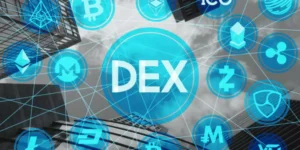Web3, as the next iteration of the internet and blockchain, has opened up unique economic opportunities, initiatives, and instruments in recent years. Cryptocurrency is being talked about everywhere today, and its active spread throughout the planet continues, allowing users to work outside the standard economic structure. As options for using capital on Web3 actively expand, one relatively novel concept called regenerative finance (ReFi) is becoming increasingly popular. Such an alternative financial system mixes decentralized finance (DeFi) with vital social and environmental purposes.
Web3 technology has enormous potential to change the global economy. Its main capabilities are decentralizing and democratizing the economic system, destroying barriers between countries, and ensuring maximum accessibility and public finance control.
The ReFi system aims to harmonize and strengthen all the essential properties of DeFi to revive the planet after centuries of mindless industrialization and unfair resource distribution. This blog post will discuss ReFi’s strengths and the risks this structure must overcome.
Understanding Regenerative Finance
ReFi provides for the creation of investment opportunities and the search for funds to adopt projects related to the sustainable development of the agricultural sector, renewable energy sources, and increasing the general well-being of society. ReFi is based on long-term thinking, not on the ability to generate income as quickly as possible. It has circular economy standards (e.g., supporting projects to reduce waste and increase recycling), as well as empowerment and access to global financial markets.
Moreover, ReFi allows people to make socially informed economic decisions, evaluate climate and social benefits, and combine significant income and sustainability goals common to all humanity.
Below, we will examine the principles of ReFi using the example of green bonds. Green bonds are financial products issued in the blockchain ecosystem to finance environmental projects.
All investors, regardless of location, can participate in selling securities directly through the decentralized bond issuance platform, eliminating the need to use a centralized underwriter. Decentralized green bonds are formed, issued, and managed through smart contracts, where primary data is specified, including interest rates, repayment periods, and distribution features.
Such green bonds are tokenized through blockchain technology; i.e., the ownership of securities occurs in a digital format. Each token corresponds to a specific bond value. Thus, each token of a company specializing in solar energy is part of the overall investment. Participants receive bond tokens in exchange for investing capital in the solar program.
The main objective of issuing such green assets is to raise capital to invest in sustainable concepts that benefit nature and develop a circular economy. Most modern green bonds also contain systems to monitor the consequences of project implementation and ensure they meet pre-established standards.
Decentralized autonomous organizations (DAOs) allow stakeholders, including investors and beneficiaries, to participate in decision-making. Let’s assume a decision has been made to form a DAO that will enable token holders to discuss decisions on new green projects for a future bond issue.
The ecosystem of green assets is steadily developing with new promising projects, expanding smart contract functionality, and positive feedback from people.


Turnkey Brokerage Solution For Your Business
Get the most profitable fully licensed fx/crypto brokerage software or ready-to-operate business in 48 hours. Best-in-class web & mobile trading platforms, sales-driven CRM, full integration with MT4/5, and 150+ payment providers.
Goals of Regenerative Finance
ReFi’s primary goal is to create a balanced, robust economy that cares about nature and society. Let’s take a closer look at the effect of such an economic system on our lives:
- Climate stabilization: ReFi strives to stabilize the climate by promoting clean energy and lifestyles to minimize carbon emissions. It decreases carbon dioxide to mitigate natural disasters, including wildfires, by creating a carbon market to control and allocate resources. ReFi cuts management spending for different countries and reduces the negative impact of various climate phenomena.
- Monitoring financial fairness: Regenerative finance strives to ensure sustainable development by maintaining a balance between people and nature. Achieving such goals involves widespread tree planting, assistance to remote regions, the creation of accessible economic services for countries with low levels of development, etc.
- Maximum financial inclusion: ReFi provides additional financial opportunities for consumers who do not have access to classic economic services. This accessibility allows people to receive the financial assistance necessary for their comfortable life and business development.
- Reducing economic risks: ReFi adopts advanced solutions, including blockchain, to create precise and reliable financial systems. It reduces commercial risks and makes the economy more sustainable, protecting entrepreneurs and financial institutions from losses.
- Improving educational processes: The emergence of ReFi enables wider adoption of academic ideas. Exploring all the framework’s features provides a more profound recognition of blockchain, ongoing development, and interconnections, forming a vast knowledge base for enthusiasts.
ReFi norms positively impact society, improving the climate of different regions, ensuring social justice, and reducing economic risks. Experts predict this system will develop even more dizzyingly in the future.
Risks of Regenerative Finance
Despite ReFi’s significant potential, many troubles arise during its implementation. One of them is ReFi scaling. Expanding such projects requires substantial capital and synchronization with classical financial systems. The meteoric success of ReFi programs, including carbon credit trading portal Flowcarbon, which raised $70 million, confirms having monetary support can make scaling and social interaction easier.
The complex and patchy regulatory framework in 2024 also poses challenges due to the lack of clear rules and support from regulatory institutions. Thus, the Toucan project, engaged in the tokenization of carbon credits, actively informs about the risks associated with the lack of precise regulation and international norms in the digital asset industry.

Remember, while ReFi programs offer significant returns regarding environmental improvements, investors often judge them as too risky, especially in the early stages (usually a fair assessment). We can recall the unstable value of KlimaDAO’s $KLIMA token, confirming the volatility and risks of such financial assets. Changing this perspective is critical to attracting capital.
Likewise, investors and the wider community must address a gap in awareness and understanding to broaden the target audience.
Adopting regenerative standards into an income-driven economic system poses significant risks and challenges. This combination requires a radical shift from a focus on generating income in the short term to long-term and sustainable environmental development.
What Is a Regenerative Finance Company?
The term «ReFi companies» includes for-profit crypto organizations, non-profit crypto institutions, and decentralized autonomous organizations (DAOs) that operate cryptocurrency token programs.
Such organizations primarily generate solutions based on blockchain to provide the planet’s sustainable development. ReFi firms include:
- Organizations that sell carbon credits.
- DAOs that raise money to fund local environmental causes.
- Firms that issue NFT to preserve cultural and historical heritage on a distributed ledger.
ReFi organizations generally issue crypto coins, which they sell through marketplaces, to accumulate funds to implement their ideas related to sustainable development. Such programs also profit people who invest capital by becoming DAO participants or buying tokens.
How does Regenerative Finance (ReFi) Compare with Decentralized Finance (DeFi)?
Decentralized (DeFi) and regenerative finance (ReFi) are two concepts that leverage the potential of blockchain, but their goals are very different. While DeFi focuses on fostering a decentralized and inclusive financial system, regenerative economics includes social and environmental impact in its commercial structure as an essential element. Let’s take a closer look at their key goals and methodologies.
Critical features of DeFi:
- High level of decentralization: The system is designed to operate independently of standard intermediaries, creating a peer-to-peer economic environment.
- Maximum income focus: DeFi maximizes income using various tactics, including yield farming.
- Environmental aspect: Although many DeFi tools have already achieved revolutionary status, especially those that require energy-intensive procedures, there is still controversy surrounding them due to their potential negative impact on the natural environment.
- Active use of innovation: DeFi demonstrates lightning-fast development, which means this structure regularly introduces advanced financial instruments.
It is necessary also to talk about some essential features of ReFi:
- Holistic approach: While ReFi still relies on decentralization, it pays close attention to the resilience and prosperity of every member of society.
- Environmental component: An essential element of ReFi is its ongoing commitment to decreasing harmful carbon emissions. Among the ReFi projects, you can find many initiatives to solve this problem.
- Long-term perspective: While DeFi is built around making quick profits, ReFi takes a more informed and responsible approach, focusing on consistent and sustainable growth over a more extended period.
- Social interaction: In addition to building a financial structure that will not collapse during the next crisis, ReFi aims to create positive transformations associated with full inclusion and collective improvement.
Despite the fundamental differences between ReFi and DeFi, these concepts can successfully complement each other. Developing decentralized blockchain-based structures that consider social and environmental aspects in addition to revenue generation is vital to forming an efficient economy. Such tactics will accelerate the transition to a fair and regenerative financial structure where everyone has equal access to sustainable investments, promoting transparency and embracing innovative technologies to solve the world’s problems.
Why Does Regenerative Finance Matter?
As we know, ReFi facilitates more efficient and effective asset management. Such a system seeks to redirect funds to finance initiatives in community development, fair trade, and the growth of renewable energy sources. Investors receive income while creating a more open and sustainable economic system.
The active implementation of projects to benefit low-income and underdeveloped groups also improves access to finance, creating a more equitable distribution of resources. ReFi also pays close attention to integrity and accountability. It offers accurate indicators and documents to ensure the program’s positive impact is quantifiable and verifiable, increasing investor confidence.
ReFi strives to create a unique financial structure that provides income and improves social and climate conditions. In this way, we can make the most fair and robust global economy.
In conclusion, 2023 has seen the active development of ReFi and an influx of non-standard programs to engage businesses and ordinary people in global issues, using crypto coins to signify their contribution and receive a return on investment. Experts believe 2024 will be the year ReFi gains even more attention and understanding, proving digital assets can impact the real world. ReFi aims to change the perception of crypto coins as a scam, turning them into a tool for creating a sustainable, low-carbon economy.






